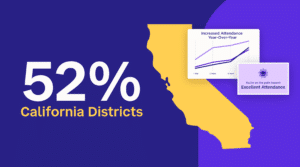
Featured Resource
Why Over Half of California School Districts Trust SchoolStatus
Read More >Join Mission: Attendance to reduce chronic absenteeism in 2025-26! >> Learn How <<





During the 2021-22 school year, 755 schools across the country closed. Population shifts, financial constraints, and education policy are among the challenges impacting public school districts and influencing decisions about school closures. Though figures vary by region, there’s evidence across the U.S. that “consolidation has been steadily increasing over the years.” Accordingly, this issue has gained attention in national policy and popular media. Despite this attention, however, empirical research in this area remains limited.
In an effort to understand the impacts of closures and consolidation, we examine some of the research to see where more attention needs to be given and how we can find solutions to the disruptions.
Eve L. Ewing—a recognized author and Professor at the University of Chicago—and Terrance Green—Associate Professor in the Department of Educational Leadership and Policy at the University of Texas, Austin—reviewed many academic studies on school closures in the last 20 years. During this time, thousands of schools shuttered, but Ewing and Green found only 53 peer-reviewed research analyses “published in education journals, education book presses, or policy briefs.” Among the identified research, they observed that most studies (60%) used a qualitative design, disproportionately focused on closures in urban settings, and inadequately addressed student, teacher, and school leader experiences. For such a widespread problem, this seems like both a limited number—and scope—of studies.
Josh B. McGee and colleagues at the University of Arkansas echo these criticisms and remark further on the lack of rigorous focus on student achievement outcomes resulting from consolidation. They acknowledge that such research is challenging due to endogeneity concerns, whereas “unobserved characteristics associated with their academic quality are likely to be associated with the probability that a district or school is consolidated.” In other words, “poor quality” is often a deciding factor in closing schools and districts. This issue complicates direct comparisons of outcomes between consolidated and non-consolidated districts due to violation of critical statistical assumptions.
Navigating this challenge, the researchers investigated achievement outcomes for students in Arkansas one year after the passage of Act 60, which mandated the consolidation of any district educating fewer than 350 students for two consecutive years. The policy’s enrollment thresholds introduced external variation and created a natural experiment the authors leveraged to compare treatment and control groups. Students’ performance on the state mathematics and ELA assessments served as the outcome of interest for achievement. McGee and colleagues found the results indicated “either null or small positive effects on the achievement of students whose districts were consolidated.” The authors explain that the statistically significant positive effects were so small in magnitude they lacked practical significance. They concluded, “Overall, Act 60 does not appear to have helped Arkansas students.” While this research didn’t show severe negative effects on students, the inability to measure any positive effects is disheartening.
Some other states had more measurable results—but still not necessarily “positive” ones. Achievement outcomes for Mississippi students whose districts were consolidated indicated students were negatively impacted by school closures. Researchers at the Mississippi Urban Research Center analyzed publicly available data for seven small rural school districts that were merged to form three districts between 2014 and 2018. They compared students’ mean scores within each achievement category on the state exam for Language and Math subjects for pre- and post-consolidation. Achievement categories were minimum, basic, proficient, and advanced. For both Language and Math testers, standardized test scores were higher pre-consolidation compared to post-consolidation. The authors remarked that their findings “are not encouraging” for students’ academic outcomes and suggest “policymakers proceed cautiously before mandating future school consolidations.”
Schools in rural areas act as cultural centers, hubs for sports, spaces for the Arts, and a location for many community activities.
Particularly for rural communities, there is evidence that consolidation has a host of negative impacts on students and the community at large. Often, schools in small communities fulfill needs that extend beyond classroom education. Schools in rural areas act as cultural centers, hubs for sports, spaces for the Arts, and a location for many community activities. If a school closes in a smaller population, both the loss of learning and the elimination of a place for community affects a larger percentage of citizens.
For these reasons, researchers dissuade a one-size-fits-all approach to consolidation. Ideally, school closure would occur equitably, in rare circumstances, and only when in the best interest of all stakeholders. Unfortunately, circumstances sometimes force policymakers into decisions they’d rather not make as they face unappealing and complex alternatives. In addition, Sally Nuamah, Assistant Professor at Northwestern University, reminds us that the majority of urban school closures show a paradox in educational attitudes, disproportionately targeting minority communities.
This issue will continue for years to come—as budget and policy changes will continue to force adjustments. So, what can we do to help students and communities during and post-consolidation? In TechTrends, Michael Kristopher Barbour recommends that educators reconsider digital learning environments as helpful supplements to reduce the number of disruptions and adjustments that are typically associated with school closures.
With the use of technology in our daily lives already, districts have the tools to extend services to students and families affected by closures. While one school may close, that school population will likely remain in the same district. With SchoolStatus Connect, districts can continue to keep families informed during consolidation, provide them with tips for managing the transition to a new school, and enable new teachers to begin building trust before the next school year begins. By engaging families with a centralized class feed (via our app or web) and providing resources and updates in the family’s preferred language and channel, districts bridge school-home communication divides and maintain connection.
 Dr. Joy Smithson
Dr. Joy SmithsonData Scientist
Dr. Joy Smithson is a data scientist at SchoolStatus, where she works with districts all over the country to help educators use data to inform decisions and support student success. Dr. Smithson sees her role as a dual mission: first, understanding educators' pressing research questions, and second, translating vast datasets into actionable insights to address those queries. While her social sciences background once made her feel like an outsider in education, she now leverages her expertise in analyzing, interpreting, summarizing, visualizing, and wrangling data to support educators. Outside work, Dr. Smithson embraces trail running and relishing the exploration of new cities at dawn.
News, articles, and tips for meeting your district’s goals—delivered to your inbox.






